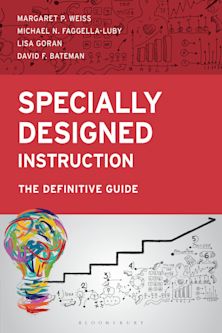Educator Perspectives of Self-Efficacy with Special Populations
From Administrators to Pre-Service Teachers
Educator Perspectives of Self-Efficacy with Special Populations
From Administrators to Pre-Service Teachers
This product is usually dispatched within 10-14 days
- Delivery and returns info
-
Free UK delivery on orders £30 or over
Description
In Educator Perspectives of Self-Efficacy with Special Populations: From Administrators to Pre-Service Teachers, the authors argue for the importance of self-efficacy in all realms of education, starting with pre-service teachers, whose efficacy levels significantly impact their classroom confidence and effectiveness. Teachers who are confident in their ability to positively impact learning tend to implement evidence-based interventions, offer constructive feedback, and cultivate supportive classroom atmospheres. Administrators who foster inclusive practices, offer professional development, and nurture positive school cultures can enhance student success. In addition, when used effectively, technology empowers educators to tailor instruction, personalize learning, and support special populations, albeit with potential challenges. Likewise, skilled classroom management fueled by high self-efficacy, establishes clear expectations, fosters positive student relationships, and effectively addresses behavioral issues. In essence, self-efficacy serves as a cornerstone in educational dynamics, shaping attitudes, behaviors, and outcomes across stakeholders. By nurturing belief in their abilities and fortifying support structures, educators pave the way for inclusive and equitable learning environments.
Table of Contents
Chapter 1: "'I think I can, I think I can': A Historical Perspective of Self-Efficacy" by Jesse Brock and Phillis M. Bunch
Chapter 2: "Secondary Pre-Service General Education Teachers' Self-Efficacy and Teaching Students with Disabilities" by Donna M. Baumgardner
Chapter 3: "K–12 Teachers' Perceptions of Teaching During a Pandemic" by Dana Kay Manning and Deborah A. Banker
Chapter 4: "Self-Efficacy of Administrators and Teachers in Serving Dually Identified Learners: The Collaboration Dilemma" by Stephanie Atchley, James E. Gentry, Juanita M. Reyes, and Jennifer Phillips
Chapter 5: "Empowering Pedagogy: Unveiling the Impact of Self-Efficacy on Technology Integration in Special Education Classrooms" by Kara Rosenblatt, Adriana Frates, and Haidee A. Jackson
Chapter 6: "Navigating the Impact of Student Behavior through Teacher Self-Efficacy" by Holly Lambert and Donna M. Baumgardner
Product details
| Published | 15 Jan 2025 |
|---|---|
| Format | Hardback |
| Edition | 1st |
| Extent | 150 |
| ISBN | 9781666944181 |
| Imprint | Lexington Books |
| Illustrations | 6 b/w illustrations; 4 tables |
| Dimensions | 229 x 152 mm |
| Series | Critical Issues in Disabilities and Education |
| Publisher | Bloomsbury Publishing |

ONLINE RESOURCES
Bloomsbury Collections
This book is available on Bloomsbury Collections where your library has access.


































